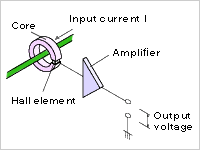
Non-contact current sensors
A wide range of products available to meet a variety of operating conditions
The power loss of the input current circuit is small,
and the structure is simple and reliable.
Hall-effect current sensors can detect DC + AC currents in a non-contact manner using a Hall element, which is a magnetoelectric conversion element. We offer a wide range of models that can detect currents from 1 A to 4000 A. As an industry leader with a demonstrated record of performance in industrial and automotive applications, we offer a diverse lineup of products that meet a wide range of needs. We can also manufacture customized products according to customer requirements. Please feel free to contact us for more information.
Hall-Effect Current Sensor Series Lineup
-
HC Series
Operating Principle

This open-loop type current sensor directly detects the magnetic field generated by the input current using a Hall element. The magnetic field generated by the input current (I) is detected and converted into a voltage by a Hall element placed in the gap of the core that surrounds the input current line. Since the output of the Hall element is small, it is amplified to a voltage of several volts by a downstream amplifier before being output.
Features
- Compact, lightweight, and reasonably-priced with simple construction
- Low current consumption
- Compatible with various power supplies
- Wide detection range and high resistance to overcurrent
-
HP Series
Operating Principle

This open-loop type current sensor converts the magnetic field generated by the input current into a voltage and outputs it, using a Hall IC. It is structured so that a Hall IC is placed in the gap of the core that surrounds the input current line. When an input current (I) flows, a magnetic field proportional to the input current is generated in the gap of the core, and this magnetic field is converted into a voltage by the Hall IC, making it possible to obtain an output voltage proportional to the input current.
Features
- Small size and low cost realized by Hall IC applications
- 5V single supply and ratiometric output
- Small temperature drift due to built-in temperature compensation circuit
-
HS Series
Operating Principle

This closed-loop type current sensor applies a feedback current to the secondary winding so that the magnetic field generated by the input current will always be zero. A Hall element is placed in the gap of the core that surrounds the input current line, and the secondary winding (N turns) is wound around the core. The feedback circuit applies a feedback current (I/N) to the secondary winding so that the output of the Hall element will always be zero, counteracting the magnetic field generated by the input current. This feedback current is converted to a voltage by a load resistor (RL), making it possible to obtain a voltage proportional to the input current.
Features
- High accuracy (good linearity, small temperature drift, and small hysteresis)
- Wide bandwidth and fast response
- High noise resistance
- Low output noise
-
HD Series
Operating Principle

This open-loop type current sensor outputs digital signals. In this method, the built-in A/D converter converts the output voltage of the Hall element to digital data and outputs data signals and clock signals (serial communication). The A/D converter uses the Delta-Sigma method. The noise shaping function of the Delta-Sigma conversion shifts noise to the high-frequency side, resulting in a high S/N ratio and improved accuracy at low frequencies. Compared to analog signal output types, this method has fewer level conversion errors and signal delays, and is less susceptible to external wiring, making it suitable for applications such as long-distance wiring.
Features
- High noise resistance due to output of digital signals (superior in noise resistance properties)
- No need for A/D conversion on the receiving side
Search for other types of current sensors
Current Sensor Product Search
Search current sensor products by operating conditions.
Product information reference
Current Sensor User’s Guide
When using our current sensors, please read the following “Handling Precautions,” “Main Characteristics,” and “Product Labeling” and use them within the specified limits.
China RoHS Hazardous Substance Information
Click here for FAQs about current sensors










